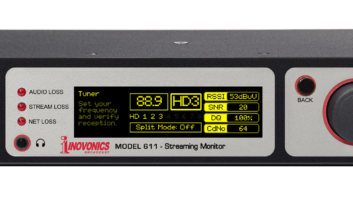Thanks for AM Feature
Big kudos for the Oct. 7 edition of Radio World, specifically the GM Journalfeature about AM radio.
I think the responses you chose to print were varied and showed a great understanding of AM radio and its problems. The solutions suggested also showed a lot of thought and understanding.
I too took exception to Randy Stine’s earlier article but knew you’d have more than enough responses to the contrary without mine. Last year, two of the top three billing stations in the nation were AMers. How was this possible in light of Stine’s pronouncement?
I did have to chuckle however over the letter from Fred Weinberg on page 36. He made one small error. His quote was, “AM radio is not dead. Many AM programmers, however, are brain dead.” This should be amended to “most” AM programmers.
Keep up the good work.
Jerry Arnold
Director of Engineering
Midwest Communications/WPRS(AM)
Terre Haute, Ind.
Live and Local
I think the most obvious way for AM to make an impact is to be live and local. There are obvious examples, WGN, WBT. But I also remember working for the owner of a couple of AMs near my rural college in North Carolina.
Even into the late 1980s, his stereo oldies AM in a tiny market held a 10.5 share in the county report, while the one FM in town, also oldies, held a 3. And his AM was a daytimer.
The AM was live and local, sign-on to sign-off, and the day was extended when we got a whopping 12 watt nighttime authorization.
His plan, way back then, was to acquire stations and adopt whatever digital standard developed. Then he would have the equivalent of a group of FM stations. Since that took so long, he sold out to buy his station elsewhere, and took stereo AM with him.
If AM would take more of a community approach, and put local voices on the air, they could gather younger demographics and develop loyalty that turns into longer TSL.
Tim Kimble
Alexandria, Va.
A Concrete Example
Reading his article in the Nov. 4 issue by Charles S. Fitch, several points about concrete and its history came to light.
I had not been aware that the secrets to formulating what we know today as Portland Cement had been lost following the time of the Roman Empire. Fascinating stuff, great article.
I want to thank Mr. Fitch for assiduously distinguishing between concrete and cement. I’m afraid there are far too many folks out there who use the word cement when referring to concrete. I can almost hear Buddy Ebsen referring to the see-ment pond in the back yard of the house in “Beverly Hillbillies.”
An architecture professor I know and respect made it clear. There is no such word as see-ment. The word is cement, and it is used to make concrete. Further, concrete is not cement, and is certainly not see-ment. Mr. Fitch correctly explains how cement is used as an ingredient in concrete, then correctly separates the terms throughout the article.
It’s like the word “console.” What is a console? Is it an audio mixer? Is it the piece of furniture the mixer sits on? Is it an arrangement of icons into a user interface on a computer screen?
Words can be confusing. In my humble opinion, an audio mixer is a mixer, a piece of furniture the mixer may sit upon is a desk or a bench, and a user interface is a GUI, an Application Desktop, an Operator Interface, anything but a console. And cement is an ingredient used in making concrete.
At least it makes communication simpler when one word is not confused with the meaning of another.
Tom Norman, CPBE
Sr. Engineer
Burst
Centennial, Colo.












